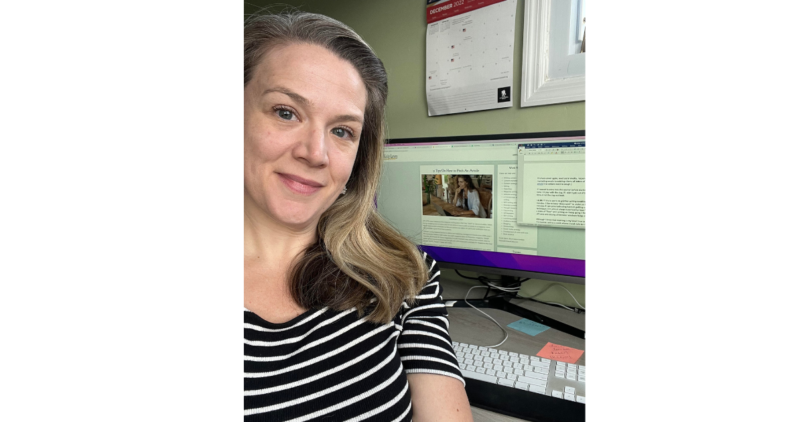

August 6, 2025
One of the best parts of being a freelancer and owning a freelance writing business is flexibility. In fact, it might be my top three benefits of being a freelance writer, in addition to “being my own boss” and having the ability to “work with a variety of clients on different projects and topics” that interest me. (Wondering ‘what is freelance?’ I’ve got you covered.) It’s a key part of this “day in the life of a freelance writer.”
I always enjoy reading about how other creatives spend their working days, discovering “a day in the life of a freelance writer” blogs, particularly if they are writers and even more so if they freelance with a family or working from home with a baby.
Since I finally have my two young children in daycare three days a week (ideally—if no one is sick!) I’ve been able to structure my workdays more and figure out the best time of day to write as well as the best time for meetings. Here’s a sneak peek at one freelancer’s schedule.
This is what a day in the life of a freelancer looks like when I have childcare and I’m able to work from home.
(Here are some freelance jobs for moms if you’re looking to make money working from home with children living at home.)
5 a.m.: Yes, sometimes a freelancer daily life starts at 5 a.m. I’m up around this time thanks to my toddler being awake. The baby gets up shortly after and the morning is spent feeding them, packing lunches, playing and reading for a bit. Then I get them dressed and drop them off at daycare. I check my personal and work emails and look at what’s scheduled for my freelance work day, making sure I have notifications pop up at least an hour before a meeting. I might post on Twitter at some point in the morning or Retweet something.
7:45 a.m.: I’m usually back home, reheating a cup of coffee, eating breakfast, showering, or walking the dog for 15 to 20 minutes in the morning.
8:30 a.m.: This is my ideal time to be seated at my computer. I usually have a short daily task list of “must dos” in the Notes app on my phone. I probably also wrote down what I have to do and any calls or appointments in a day planner on my desk. I’m experimenting with a day planner that has lines for each hour so I can write down what I should be working on during that time frame.
Seeing these tasks and assignments written down helps me stay on task and focused. Instead of browsing LinkedIn, skimming Twitter, and reading headlines, I should be writing in the morning. This is the best time of day for me to write blogs for my site, LinkedIn articles or posts (follow me here), or client assignments. Even though I’m a professional writer and I’ve been freelancing for over 15 years, the task of writing still weighs on my brain and I feel lighter and more productive after I get something done.
10 a.m.: Work break, caffeine break, stretch, hydrate and “reward” myself for writing with some other work reading.
I’ll check email again, read social media, respond to work emails and probably send out some marketing emails to existing clients of letters of introduction. (Get tips on how to pitch an article that editors want to assign.)
If I toss laundry into the washer before starting my workday, I’ll put it in the dryer around this time. (Could a freelancer daily life be any more exciting?). I’ll play with the dog. If I haven’t gotten out of the house by now yet, I might do it around this time or let the dog out back. All of this makes for a super exciting day in the life of a freelancer amiright?)

11:30: I’ll try to work on another writing deadline or some focused client work or 30 or 45 minutes. I like to keep “deep work” to under an hour and even set a timer via Google for 25 minutes if I am procrastinating hard on getting something done. (It’s called the Pomodoro technique.)
I’m almost always surprised by how fast those 25 minutes go by and I’m often in a state of “flow” with writing, so I keep going. I find that “pausing” my inbox on Gmail, turning off texts, and closing all browser windows helps me stay in the zone. It’s just one way I keep the creativity going while writing a freelancer daily life each workday.
Although I know that morning is my ideal time to work, it is my preferred time to exercise, too. I’m hoping I get to a point where I head right to the gym after dropping my kids off so I get that out of the way and feel energized to start my “day in the life of a freelance writer” schedule. I’m not there yet!
12:30 p.m.: I’ll have a lunch break and might catch up on texts with my husband, family and friends. I’ll browse Facebook groups, add comments to LinkedIn and respond to comments on my posts, respond to emails, and might listen to one of these top podcasts for freelancers.
1 p.m.: If I didn’t send out marketing emails earlier and follow up with previous clients, I’ll do that sometime between 1 and 4 p.m. I might block out 30 minutes for writing pitches to send to an editor or try to find new, higher-paying freelance clients as part of my weekly marketing strategy.
I track my time with Togg.l’s free app and desktop application. (It’s one of my 20 perfect apps for writers and freelancers.)
I usually spend about half of my work hours on things like “marketing,” “reading emails,” “social media updates and reading,” as well as general work reading to stay on top of industry trends. I also lump my blog writing for my website and writing posts on LinkedIn into this category as well.
Basically, these are hours spent that I don’t get paid for. Staying on top of my freelance marketing strategy is key when it comes to having consistent client work.
How many hours do freelancers work? I average about 15 to 20 hours of freelance work each week now that my kids are in daycare for three days (approximately 26 hours).
Paid client work accounts for about 10 to 15 hours of freelance workweek. That’s why I try to make sure I’m always earning a freelance hourly rate of $100 an hour or more.
If I’m going to have a coffee or tea I try to make sure I’m done drinking it by 2 p.m. so it doesn’t interfere with my sleep at night. I find a little java in the afternoon can truly help my productivity!
2:30 p.m. to. 4 p.m.: By this time, my creative energy is lagging. I don’t think I do my best writing in the afternoon and evening. I try to reserve this time for email responses, freelance coaching calls, client calls, or connecting with my freelance network on social media.
If I haven’t left my home office yet, I need to get out by now. (Leaving one’s home is key when you are exploring write a freelancer daily life while keeping sanity intact.) I may go to the library or a coffee shop to do a little bit of work. There’s probably a snack break in there somewhere as well.
On the other end of my freelancer daily life tasks? I’ll close out my workday by planning what I need to get done the next time I’m able to work, socialize with my husband, start dinner, or finish laundry. Since this “day in the life of a freelance writer” is only three days a week, I need to make sure my work is done for the next day or a newsletter is scheduled to go out a few days later.
When my kids are home with me two of the weekdays, I might be able to get 30 minutes of work done if they both take naps at the same time. Or, if there’s something important I need to tackle, I sneak away for an hour after my husband comes home from work or I’ll hire a babysitter for two hours.
I’ll check work emails at some point in the evening and might respond if it’s important—like if an editor wants to know if I’m able to take on an assignment. (Otherwise, I’m afraid I’ll forget about them a few days later.)
Love this? Here’s what a 20-year freelance veteran does to find great clients and steady work. It’s a sneak peek into a freelancer daily life of a different freelance writer.
Tags: freelance writing, freelance writing tips, freelancer, parent
Leave a Reply